Sept. 17, 2025
Thesaurus : Doctrine
► Référence complète : I. Kampourakis, « Transparency Legislation in Global Value Chains: Decentralization Market Power, and Global Hierarchies", in H.Shamir, B.Arora, S. Banerjee & T. Barkay (ed.), Modern Slavery and the Governance of Global Value Chains, Cambridge University Press, series "Development Trajectories in Global Value Chains", 2025, pp.70-94.
____
📗Lire l'ouvrage dans lequel cet article est publié
____
____
July 2, 2025
Conferences
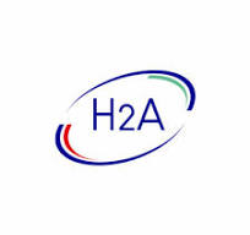
🌐follow Marie-Anne Frison-Roche on LinkedIn
🌐subscribe to the Newsletter MAFR Regulation, Compliance, Law
🌐subscribe to the Video Newsletter MAFR Surplomb
🌐subscribe to the Newsletter MaFR Droit & Art
____
► Full Reference: M.-A. Frison-Roche, "L'enjeu de la crédibilité des rapports de durabilité. Temps long, Simplicité et Stratégie" (The credibility of sustainability reports. Time, Simplicity and Strategy), concluding speech, in Rencontres de la Haute Autorité de l'Audit (H2A), 2025, Mise en œuvre de la directive CSRD. Premiers constats et perspectives (Annual Manifestation of the French Audit Regulatory Body Haute Autorité de l'Audit - H2A, Implementation of the CSRD directive. Initial findings and outlook),, 2 July 2025, La Défense, 1pm-6pm
____
This manifestation, which takes place face-to-face with simultaneous translation, begins with a presentation by Florence Peybernès, President of the French High Audit Authority ( Haute Autorité de l'Audit -H2A).
It is followed by 3 round-table discussions:
🪑🪑🪑 Round table 1: Feedback on the first appointments
🪑🪑🪑 Round table 2: Cross-perspectives between preparers, verifiers and stakeholders
🪑🪑🪑 Round table 3: Perspectives for CSRD
It is following on from this that the more legal, more judicial perspective, in an articulation between Ex Ante and Ex Post, will take shape.
____
► English summary of the speech, as prepared : n view of the information available at the time of preparation for this event, the considerable interest aroused by the CSRD, and also its contestation, which led to its modification, is it counter-intuitive in view of the technicality of the remarks, the flood of criticism and the number of pages one reads, the impression of the weight, constraints and uselessness of the thing which would deprive companies of their freedom, but what emerges rather is Simplicity. Why: because the sustainability report is only a tool and it is the goal it serves that needs to be considered (more generally that's how the judge looks at it), a tool that serves a European strategy (Green Deal, sustainable finance). It is this strategy that needs to be identified, and the company has a free hand in it. What we are looking at the company in its contribution to this goal that is simple, a contribution which it can, in information that is admittedly standardised, draw the outlines of
Long-term and Strategy: Investors and stakeholders are not hostile to this approach: the key is the credibility of the information made available. Because Long-Term Thinking puts the future at the centre, and we don't know what that future will be. This essential element, which the courts have recalled in relation to Vigilance Obligation, must also be borne in mind, because it is first and foremost a question of providing information about the future.
To express the Information they want to give on this subject, companies need to understand the Goal of the European Plan (where Simplicity lies), to adjust their own plan to it (under the more familiar term of "Strategy") the councils and lawyers need to help them with this; to blend their strategies with the European strategy, to rely on the authorities and the auditors so that what they say is credible. Credibility is at the heart of it, which is why auditors are at the heart of it.
Because the only obligation they have is to say. Not to do. The CSRD should not be interpreted as imposing obligations on the companies subject to it to do things (such as the obligation of vigilance generates); the CSRD only imposes an obligation on them to say things. The CSRD imposes on them only an obligation to inform. While this may be onerous, standardised and certified, there is no obligation to do or disclose anything. Moreover, that is part of the company's own strategy, a strategy over which the company retains full control. In this respect, although standardised, the information is free and it is the credibility of the information that is crucial, but not participation in a plan whose terms would be written by the Authorities or the stakeholders.
Therefore, after learning from each other, it seems that there are three fairly simple things that are sometimes buried under the complication of the details accumulated and the violence of the arguments exchanged around the European Omnibus package. These three points will be developed at the end of the round-tables.
The first is the simplicity of the breadcrumb trail of credible, accessible information imposed by the European Union to put the Green Deal into practice. This breadcrumb trail is held in particular by the various regulators.
The second is the existence of a single, simple obligation on the part of the company: to say what it has done, is doing and plans to do, without being obliged to do anything in the European Action Plan (the CRSD does not forcibly enroll companies in the European action plan). This limitation to an obligation to say is essential. Its articulation with obligations to act, arising in particular from texts on Vigilance, or even identical terms, must not lead to confusion in qualifications.
The third is the benefit that the company derives from the articulation of a double "singular strategy": that of the European Union, which wants to build its future, a strategy of the Union to which it is free to contribute or not to contribute, and that of its own strategy which is articulated with the first and in which green gives way to many other colours according to the will of the company.
► English Summary of speech, as made with regard to what effectively was said during the 2 round tables: During the event itself, I preferred to place myself rather in the direct continuation of what had been said. In the fifteen minutes allotted, this was the reason for not proceeding in this way, but rather to highlight the fact that what has emerged, all these efforts, uncertainty, trial and error and goodwill to elaborate that went into drawing up the first sustainability reports, runs the risk of being erased because in retrospect, in 2 or 5 years' time, particularly if a lawsuit were be brought, we will have the impression that everything was self-evident, that we knew everything, that everything was clear and decided. And it's that future, which will be the future of the judge who will be called upon by a stakeholder, a regulator, a prosecutor, who always takes the past for granted, that we have to think about. We need to think in terms of evidence. Evidence of uncertainty. And always remember that the sustainability report is also a piece of evidence. Which will fuel liability claims, disputes over information, and so on.
Plus encore, parce que le report de durabilité n'est qu'un outil, pour une stratégie, qui est une stratégie d'ensemble, où la CSRD n'est qu'un élément du puzzle, des éléments du rapport de durabilité peuvent être pris pour être utilisés plus tard pour alimenter d'autres documents et rapports, et d'autres litiges. Cela est notamment le cas du plan de vigilance, puisque la cartographie des risques est souvent commune au rapport de durabilité et au plan de vigilance, ce qui est logique puisque la CSRD et la CS3D se font miroir dans le grand plan d'action de l'Union que constitue le Pacte vert. Mais cela est amplifié par les entreprises, qui parfois confondent l'un et l'autre, dans la présentation même au sein du rapport de gestion. Il est pourtant essentielle de distinguer nettement l'obligation de dire (rapport de durabilité) et l'obligation de faire (plan de vigilance). L'ambiguïté des "engagements" accroît cela. Il est essentiel de veiller à un travail ex ante entre expert de la gestion, de la finance, de l'audit et du droit pour éviter que les points de contact ne se transforment en confusions, maintenant et /ou plus tard, confusions qui pourraient être préjudiciables à tous.
________
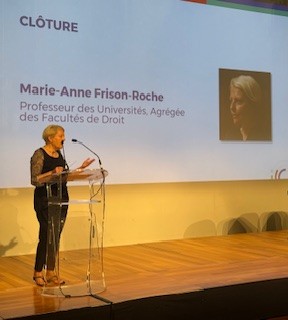
Nov. 30, 2023
Conferences
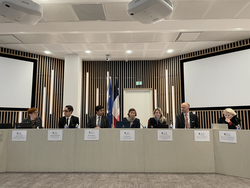
🌐follow Marie-Anne Frison-Roche on LinkedIn
🌐subscribe to the Newsletter MAFR Regulation, Compliance, Law
____
► Full Reference: M.-A. Frison-Roche, "Conclusion", in M. Boissavy, H. Dehghani-Azar, and M.-A. Frison-Roche (dir.), Journal of Regulation & Compliance (JoRC) and Conseil national des Barreaux (CNB), Compliance, vigilance et médiation (Compliance, Vigilance and Mediation), Amphitheatre of the Conseil national des Barreaux, November 30, 2023.
____
🧮see the full programme of this event
________
March 23, 2023
Thesaurus : Doctrine
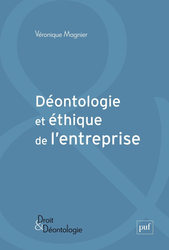
► Référence complète : V. Magnier, Déontologie et éthique de l'entreprise, PUF, coll. "Droit & Déontologie", 2023, 260 p.
____
📗lire la 4ième de couverture de l'ouvrage
____
📗lire la table des matières de l'ouvrage
____
► Résumé de l'ouvrage (fait par l'éditeur) : "La déontologie et l'éthique d'entreprise naissent de sources éparses, embrassent un large champ thématique et s'étendent à de nombreux acteurs.
Le conflit d'intérêts est au coeur des préoccupations déontologiques de l'entreprise, comme en témoignent les procédures pesant sur ses acteurs-clés, dirigeants et actionnaires de référence. Les bonnes pratiques de gouvernance, inspirées des théories sur la gouvernance d'entreprise, se muent aussi en règles déontologiques consignées dans les codes de gouvernance. L'entourage des actionnaires n'est pas épargné, notamment les agences de conseil en vote sur qui pèsent des règles déontologiques.
L'éthique d'entreprise est aussi en plein essor. On distingue l'éthique de la transparence, celle des compliances et celle de la vigilance. Ces nouvelles normes éthiques suscitent de fortes attentes, notamment au regard des préoccupations sociétales, environnementales, de la défense des droits de l'homme ou de la lutte contre la corruption.".
Dec. 8, 2020
Thesaurus : Doctrine

► Référence complète : A.-S. Epstein, "L'information économique", in J.-B. Racine (dir.), Le droit économique au XXIe siècle. Notions et enjeux, LGDJ, coll. "Droit & Économie", 2020, pp. 417-459
____
📕consulter une présentation générale de l'ouvrage, Le droit économique au XXIe siècle. Notions et enjeux, dans lequel cet article est publié
____
► Résumé de l'article :
____
🦉Cet article est accessible en texte intégral pour les personnes inscrites aux enseignements de la Professeure Marie-Anne Frison-Roche
________
June 16, 2016
Thesaurus : Doctrine
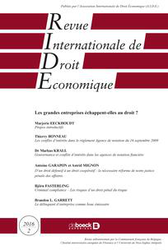
Référence complète : Eeckhoudt, M. (dir.), Les grandes entreprises échappent-elles au droit, Revue Internationale de Droit Économique (RIDE), 2016/2,De Boeck, (introduction, par Marjorie Eeckhoudt, p. 151-163.).
Les étudiants de Sciences po peuvent lire l'article via le drive dans le dossier "MAFR - Régulation" les différents articles qui constituent le dossier.
L'auteur présente dans l'introduction le dossier consacré à l'articulation entre la compliance et la responsabilité pénale.
Elle y voit l'importation du droit américain dans un "copier-traduire-coller". Elle y voit à la fois la puissance du droit et un moyen pour les grandes entreprises qui multiplient les chartes d'échapper aux droits nationaux.
Elle estime que cela participe des "divers instruments de la régulation", assistant notamment à un retour de la réglementation, par exemple à propos des agences de notation et la règle comply or explain.
Or, "compliance rime avec indépendance" (p.158) et l'agence de notation n'est pas toujours indépendance de son client : c'est pourquoi le conflit d'intérêts est au cœur de la compliance. "compliance rime avec transparence" (p.158).
L'auteur explique le souci d'efficacité guide aussi désormais la responsabilité pénale, à travers la négociation pénale ou l'accueil du lanceur d'alerte. Mais l'efficacité n'est encore la mieux servie en matière de sanction.
Dans ce dossier voir aussi :
BONNEAU Thierry, Les conflits d'intérêts dans le règlement Agence de notation du 16 septembre 2009.
KRALL Markus, Gouvernance et conflits d'intérêts dans les agences de notation financière.
FASTERLING Björn, Criminal compliance - Les risques d'un droit pénal du risque.
GARRETT Brandon L., Le délinquant d'entreprise comme bouc émissaire.
_____
Aug. 10, 2004
Publications
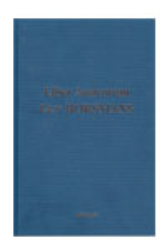
► Référence complète : M.-A. Frison-Roche, "Principes du droit des sociétés et prudence de gouvernement", in Liber Amicorum Guy Horsmans, éd. Bruylant, 2004, pp.461-470.
____
____
► Résumé de l'article : Traditionnellement, le bon gouvernement des sociétés était laissé à la loi naturelle de la prudence patrimoniale, car si le dirigeant est associé, la gestion l'entrainant dans la fortune ou la ruine de l'action sociale, il sera de ce fait prudent. La financiarisation de l'économie, la dislocation entre actionnariat et direction, l'imagination juridique et financière, ont fait perdre cette naturelle loi. Ces artefacts que sont l'éthique ou la transparence tentent de la rendre. Plus encore, la procédure entre dans la société, à travers les droits de réponse, d'information, de préparer ses arguments. Comme Habermas le montra pour l'espace politique, l'espace des affaires se replie aujourd'hui sur une légitime procédurale.
Dans sa conception libérale, le droit limite le pouvoir en conservant aux individus l'espace de leur liberté, en supposant qu'ils connaissant leurs intérêts propres, qu'ils font les servir, et que cela-même constitue la limite de leur pouvoir, la limitation du pouvoir étant ce pour quoi est fait le droit.
Lorsqu'il s'agit de gouverner les sociétés, le raisonnement classique a consisté à s'en remettre à la prudence patrimoniale. En effet, la personne ne va pas nuire à ses intérêts financiers. Dès lors, il faut mais il suffit que le dirigeant social soit associé pour que, étant entraîné dans la fortune ou dans la ruine de la gestion, il soit sage dans celle-ci. La loi naturelle de la prudence suffit à le tenir. Cette conception ploutocratique du pouvoir fonde dans la société commerciale le lien entre le droit de vote et l'ampleur de la détention du capital. On observe d'ailleurs que les sociétés que l'on désigne comme des sociétés "patrimoniales de famille" soient gérées plus sagement, efficacement et sur le long terme que les autres.
Mais la financiarisation de l'économie a eu raison de cette logique patrimoniale. L'assise patrimoniale n'est plus accessible et il est si aisé d'acquérir le pouvoir si en payer le prix. L'alliance de l'imagination du droit et de la finance y pourvoit.
Il faut donc regarder d'autres modes, cette fois-ci artificiels, pour que les sociétés soient gouvernées sagement. Il pourra s'agir de l'éthique ou de la transparence, l'ensemble s'accompagnant d'une forte pénalisation.
En outre, la procédure pénètre dans la société, non seulement les droits de la défense au profit du dirigeant que l'on songe à révoquer mais encore l'organisation de débat et les droits à l'information, qui finissent à faire ressembler la vie sociétaire à un procès permanent. La légitimité du pouvoir devient procédural. Habermas l'avait démontré pour la vie politique. Cela est désormais acquis pour la vie des affaires.
________
April 5, 2001
Thesaurus : Doctrine
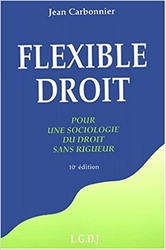
Référence complète : CARBONNIER, Jean, Transparence in Flexible droit. Pour une sociologie du droit sans rigueur, 10ème éd., LGDJ, 2001, pp. 315-323.
________
Consulter la présentation de l'ouvrage.
Les étudiants peuvent accéder à l'article via le Drive de Sciences Po, dossier "MAFR-Régulation".